If you are not a tech-savvy user and you will soon be faced with the question of choosing a mobile phone or smartphone with a touch screen, you will probably come across terms such as “capacitive screen” or “resistive screen” when reading mobile device specifications. And then a completely logical question will come to your mind - which one is better: resistive or capacitive? Let's find out how touch displays differ, what types of them exist and what are their advantages and disadvantages.
RESISTIVE SCREENS
Speaking in an accessible language, avoiding wise technical terms and turns, a resistive touch screen is a flexible transparent membrane on which a conductive (in other words, resistive) coating is applied. Under the membrane is glass, also covered with a conductive layer. The principle of operation of a resistive screen is that when you press the screen with a finger or a stylus, the glass closes ...
0 0
Touch screens on devices are divided into two main types, which have significant differences.
Resistive touch screen.
Such a screen consists of several layers. When you press the screen, there is a short circuit with the membrane. The gadget registers this change, converts it into coordinates, by which it determines exactly where you clicked, and reacts to pressing accordingly. For example, opens a program or selects a specific menu.
High strength. Such screens are made from various grades of fiberglass. Small cost. Resistive screen has a simple working principle.
The disadvantage is the low sensitivity. Simple finger touches are often not recognized by the device, so you will have to use a stylus or long nails.
Capacitive touch screen.
Such a screen consists of a layer of glass covered with an electrical conductor. The human body is a good conductor of electricity, so when you touch the screen, you...
0 0
Before considering a capacitive or resistive screen, you need to decide what touch technology is in general. Everything is clear here: this is a screen that determines the coordinates of pressing. Scientifically speaking, this refers to a method of managing the interface, with which the user can click directly on the place of interest. On the this moment There are several methods for implementing touch screens. It is worth considering each separately.
Resistive technology
To determine which type of screen, capacitive or resistive, is best for you, you need to consider them. The second option involves the use of production technology. Below is a glass panel, on top of which there is a transparent flexible membrane. There is a conductive coating on the panel and the membrane, that is, resistive. When you click on the screen, a closure occurs at a certain point. If you know the voltage...
0 0
Can be found a large number of touch displays, differing not only in design features, but also in the principle of operation. To date, there are the following types touch screens: resistive, capacitive, projective-capacitive, matrix, touch screen on surface-acoustic waves, infrared, tensometric, inductive.
At present, two main types of touch screens are used in electronic engineering: resistive and capacitive. We will talk about them in more detail, and also try to highlight the strengths and weaknesses of each.
Resistive touch screen
First, let's look at how a resistive touch screen works. It consists of a glass panel and a flexible plastic membrane coated with a resistive coating. The space between the glass and the membrane is filled with micro-insulators, which, in turn, reliably insulate conductive surfaces, evenly distributed over the active area of the screen. By clicking on...0 0
Capacitive vs resistive ArchiveMobilis
What is the difference between capacitive screens used in the iPhone and other modern mobile devices, from other types of touch displays? And are they the future?
Repeatedly made sure that ordinary users utterly unaware of the existence different types touch screens and learn with genuine amazement that the lack of response of the display of a freshly bought communicator to the usual poking with a pencil is not at all a sign of a malfunction. It's just a different screen, built on a different technology. Even some sellers are confused in the testimony, attributing the properties of others to displays of one type. So first we will brief educational program, after which you will be able to distinguish different types of screens literally by touch. And then we'll talk about which one of them is the future.
Modern mobile devices - smartphones, communicators, players - use ...
0 0
Often, when choosing an Internet tablet, a person reads a lot of reviews and reviews and simply drowns in new, unfamiliar terms and concepts. So, for example, not everyone knows what a resistive screen is. It is hardly necessary to prove that the display is the most important part of a tablet PC (and any other mobile device), so let's deal with this concept.
What is a resistive screen?
The answer can be very short:
A resistive touch screen is a display made by the technology of the same name. This provides its special properties compared to another common type of screen - capacitive.
And now let's sort it out on the shelves, what kind of technology it is and what it means for the end user (the buyer of the tablet).
Manufacturing technology of resistive displays
In general terms, the problem of turning a stylus or a fingernail into a kind of computer mouse is achieved as follows.
The sensor consists of two (usually) layers: glass and...
0 0
Resistive or capacitive touch screen
To stop getting confused, just remember: resistive screens are pressure sensitive, and capacitive screens are touch sensitive. This difference is due to the design of the displays, and to accustom, for example, capacitive screen to recognize the strokes with a pencil is impossible in principle.
How a Resistive Touch Screen Works
A resistive touchscreen is like a layered sandwich, in analogies. When you press the screen, it closes with the membrane, the device registers the change in resistance and converts it into coordinates, so your tablet knows that you clicked here and reacts accordingly. For example, opens an application or pauses the game. Their strengths are that they are quite strong, as they are made from various grades of fiberglass. Given that this is a fairly simple design, the resistive screen also has a relatively low cost, so the resistive touch screen...
0 0
The touch screen is an information input device based on the coordinate principle of perception, which responds to touch. They usually become an alternative to a whole bunch of mechanical buttons, which is quite convenient, as it allows you to combine the display and the input device. The reliability of such a system is much higher due to the fact that there are no mechanical and moving parts.
The very first models of touch screens were created in the late sixties of the last century, it was then that the scientist Samuel Hurst realized that he did not want to read kilometers of tape recorders. In 1971, he founded the Elotouch company, which released the eliograph, which was the first computing device to have a resistive touch screen. Some time later, his company merged with another called Siemens, after which it became known as Elographics. Through this collaboration, touch panels were developed for kinescopes,...
0 0
Display: capacitive or resistive, which is better?When choosing touch smartphone the question may arise, which touch phone is better: with a resistive or capacitive screen? Let's say right away that none of these technologies is superior to the other qualitatively, both of them have their pros and cons. So the user should compare all the advantages and disadvantages and choose the lesser of two evils =)
In this article, we will talk about the advantages and disadvantages of capacitive and resistive screens.
Resistive type screen features:
The resistive touch screen is characterized by a relatively low cost and maximum resistance to contamination. The resistive screen responds to touch with any hard smooth object: hand (including gloved), stylus, credit card, pen, while in some phones, touches are accompanied by a response, vibration feedback, which makes the work more comfortable and enjoyable. Plus, resistive technology allows you to use ...
0 0
10
Your phone's touchscreen: resistive, capacitive, or projected capacitive
Touch screens today are an integral attribute of a modern mobile phone, although they received mass distribution relatively recently - in 2007. And if you are going to buy a smartphone, you are unlikely to find among the new models those that would not be equipped with a touch screen. Despite the fact that adherents of conventional hardware keyboards are having a hard time switching to touch control, it is the touch devices that are being released more and more. And for those who appreciate convenient typing, they release touch phones in a classic form factor or in a side slider form factor, which are additionally equipped with hardware QWERTY keyboards.
Touch phones and smartphones in different form factors
Often the phrase "touch screen" is replaced by another - "touchscreen", which is a bunch of two English words (touch - touch, touch and screen - ...
0 0
11
Tablets, or as they are also called - tablets, based on the operating Android systems- one of the fairly new gadgets that will allow you to chat with your friends, browse the World Wide Web (Internet), as well as watch movies and listen to your favorite music. As a rule, they are of a small flat shape, have lost a significant part of their mass and a fairly voluminous keyboard, which is now associated with their older laptop brother. If there is no keyboard, you ask, how to work with them?
Every tablet has a touch screen. It's a screen that responds to your touch, just like Touchpad at the laptop. This way, instead of clicking on the icons with the mouse, you can simply touch them with your finger or stylus (looks like a pen, but without ink).
There are different types of touch displays, so let's see what they are and what are the differences between them:
Resistive touch screen
Resistive...0 0
12
Hello dear readers. Because I’m already specifically tired of the fact that various unscrupulous (and more often simply ignorant) journalists are constantly speculating on the topic of touch screens, I decided to enter small educational program in terms of resistive touch screen, capacitive touch screen and multitouch (multitouch). After reading this article, you will understand why the presence of a capacitive touch screen does not mean multi-touch, and also why the iPhone has a real multi-touch, while the rest are just a crooked attempt to imitate it. I warn you in advance that the article has not been paid for by anyone, and the power structures of the Russian Federation have nothing to do with its appearance at all.
So, first, let's define what a touch screen is. Everything is simple here: this is a screen that tracks the coordinates of pressing. Or, more scientifically, it is a method of interface control that allows the user to tap directly on the screen. In short, a no brainer what it is. There are several methods for implementing a touch screen. About...
0 0
13
Screens modern devices can not only display an image, but also allow you to interact with the device through sensors. Initially, touch screens were used in some pocket computers, and today touch screens are widely used in mobile devices, players, photo and video cameras, info kiosks, etc. In addition, each of the listed devices can use one or another type of touch screen. Currently, several types of touch panels have been developed, and accordingly, each of them has its own advantages and disadvantages. In this article, we will just consider what types of touch screens are, their advantages and disadvantages, as well as which type of touch screen is better.
There are four main types of touch screens: resistive, capacitive, surface acoustic wave detection, and infrared. In mobile devices, only two are most widely used: resistive and capacitive....
0 0
14
With the advent of touch screens, people who buy a Chinese mobile phone often do not suspect that there are different types of them, and if the sensor does not work well on your phone, this does not mean that your mobile phone is broken at all, but it may simply be that this phone has a different a screen type that you are not used to yet.
And now we will help you sort out this confusion. There are two types of touch screens in Chinese phones they are: resistive screen and capacitive screen. Next, we will talk in more detail about each of them. Then you will be able to distinguish between these screens, with the first touch.
So that you stop getting confused, I suggest you remember a simple truth about these screens - resistive screens are pressure sensitive, and capacitive screens are sensitive to touch. They have a completely different display design, and it is impossible in principle to accustom, for example, a Chinese mobile phone with a capacitive screen to a stylus or a fingernail.
The resistive screen is a glass...
0 0
15
In our time, touch screens have long ceased to be exotic. They all look similar on the outside, but are these displays really the same? Let's look at the design of the main types of sensitive screens, their advantages, disadvantages and scope.
Today, sensors based on capacitive and resistive technologies, as well as their varieties, are most widely used.
"Multitouch"
This is the name of the technology that allows you to recognize pressing the touch screen at several points at the same time. This opens up new possibilities in device management. An example of the use of multi-touch technology is the interface Apple iPhone.
Capacitive touch screens
The capacitive touch display actually responds to touch. It is a glass panel coated with a transparent conductive compound. Four electrodes are placed at the corners of the panel, to which an alternating current is supplied....
0 0
16
The touch screen is a device for input and output of information through a touch and gesture sensitive display. As you know, the screens of modern devices not only display an image, but also allow you to interact with the device. Initially, familiar buttons were used for such interaction, then a no less famous “mouse” manipulator appeared, which greatly simplified the manipulation of information on a computer display. However, the mouse requires a horizontal surface to work and is not very suitable for mobile devices. This is where an addition to a regular screen comes to the rescue - Touch Screen, which is also known as Touch Panel, touch panel, touch film. That is, in fact, the touch element is not a screen - it is an additional device installed on top of the display from the outside, protecting it and serving to enter the coordinates of touching the screen with a finger or other object.
Usage
Touchscreens today...
0 0
17
The first appearance of touch screens fell on the era of handhelds of past years - PDA or, in English, PDA. Gadgets were interesting, but absurdly low-functional, and therefore did not take root, unlike touchscreens.
Moreover, the latter not only stood the test of time, but also became the cornerstone of the concept of all modern mobile gadgets. It’s almost impossible for us to imagine something non-stationary with a QWERTY keyboard, and in recent years, touch displays have “learned” to be really responsive and easy to use. Although their designs have not fundamentally changed and are divided into the same 3 main categories.
Resistive systems
Imagine a conductor in the form of a thin and flexible metal plate, and opposite it is a glass panel coated with conductive paint. If you press something on a metal plate, it will bend and touch the coating on the glass. And since both surfaces are constantly running electrical ...
0 0
At present, you will not surprise anyone with a touch screen. Moreover, it is already strange to see devices without a sensor, especially when it comes to mobile gadgets. This is due to the desire to increase the area of the working surface. But how often do we think about what type of display is used in a particular device? Has it ever happened that, having bought a new tablet or smartphone, we try to control it with the usual digital pen, but bad luck, the device simply does not respond to its touch. Apparently, the screen is made using a different technology, capacitive, which is gradually beginning to replace its predecessor, a resistive type display.
You can find a large number of touch displays that differ not only in design features, but also in the principle of operation. To date, there are the following types of touch screens: resistive, capacitive, projective-capacitive, matrix, touch screen on surface-acoustic waves, infrared, tensometric, inductive.

At present, two main types of touch screens are used in electronic engineering: resistive and capacitive. We will talk about them in more detail, and also try to highlight the strengths and weaknesses of each.
Resistive touch screen
First, let's look at how a resistive touch screen works. It consists of a glass panel and a flexible plastic membrane coated with a resistive coating. The space between the glass and the membrane is filled with micro-insulators, which, in turn, reliably insulate conductive surfaces, evenly distributed over the active area of the screen. When the display is pressed, the panel and membrane are closed, and the controller, using an analog-to-digital converter, registers a change in resistance, converting it into touch coordinates. It is for this reason that such a screen can be pressed with any hard object, it can be either a fingernail or a special stylus, or even an ordinary pencil. As a consequence of this structure, resistive screens gradually wear out, which is why it becomes necessary to periodically calibrate the screen so that when you press the display, the coordinates of the touch point are correctly processed.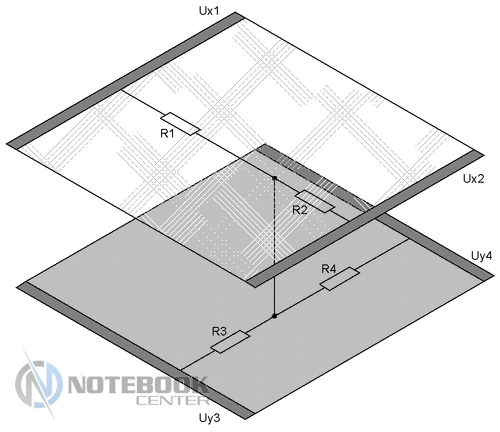
There are four-, eight-, five-, six- or seven-electrode screens. The easiest to manufacture, and therefore the cheapest, are four-electrode. They withstand only 3 million clicks in one point. Five-wire will already be much more reliable - up to 35 million clicks, they have four electrodes located on the panel, and the fifth is on the membrane, which is covered with a conductive compound. It is worth noting that five-wire and subsequent versions of six- and seven-wire shields continue to work even if part of the membrane is damaged.
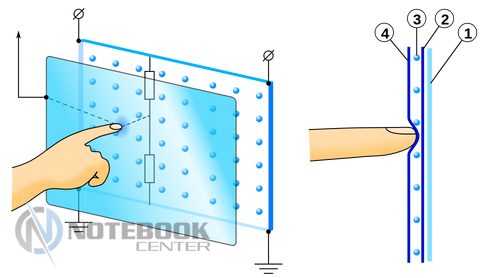
Advantages
The advantages of a resistive screen include the low cost of its production, and, consequently, the device in which it is used. In addition, it is worth noting that the response of the sensor here does not depend on the condition of the screen surface, even in case of contamination, the touchscreen remains just as sensitive. It should also highlight the accuracy of hitting the desired point, because. a dense array of resistive elements is used.

Flaws
As disadvantages of resistive screens, we single out low light transmission, no more than 70% or 85%, therefore, increased backlight brightness is required. It is also low sensitivity, i.e. just touching with a finger is not enough, pressure is required, so a digital pen or long nails are indispensable. This type in most cases, it does not support multitouch, i.e. the screen understands only one touch. When interacting with the screen, you need to make some efforts to transmit any command, and overdoing it can not only scratch, but also damage the display. As mentioned above, for proper functioning, it is necessary to periodically calibrate the screen.
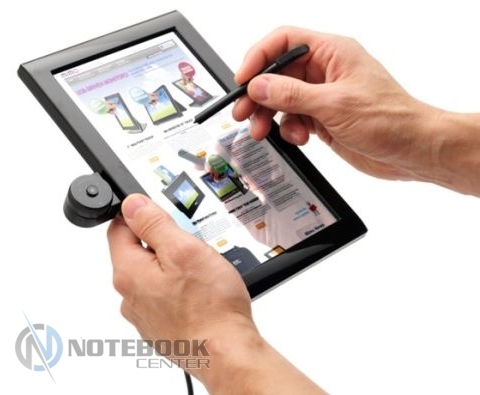
Capacitive touch screen
A capacitive screen is a glass panel that is coated with a transparent resistive material that typically uses an alloy of indium oxide and tin oxide. At the corners of the panel, electrodes are installed that supply low-voltage power to the conductive layer. AC voltage, they monitor the flow of charges on the screen, and transmit data to the controller, thus determining the coordinates of the touch point. Before touching, the screen has some electrical charge; when touched with a finger, a point appears on the conductive layer, the potential of which is less than the potentials of the electrode, since the human body has the ability to conduct electric current and has a certain capacitance. There are no flexible membranes on the screen, which ensures high reliability and allows you to reduce the brightness of the backlight. This type of screen is able to simultaneously determine the coordinates of two or more touch points, which means multi-touch support.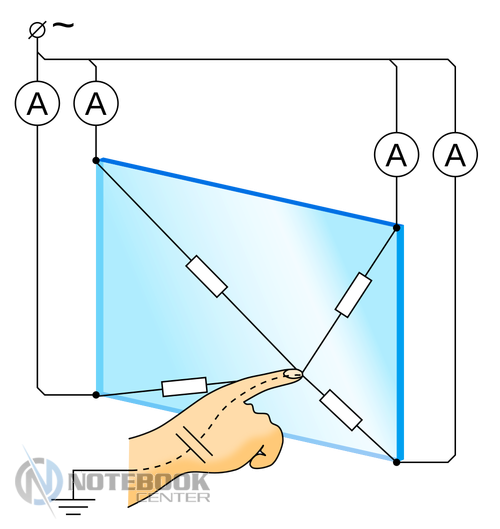
A subspecies of capacitive steel projection-capacitive screens. They work on a similar principle. The difference lies in the fact that the basic elements in them are located not on the outside of the screen, but on the inside, which makes the sensor more secure. Mostly displays of this type are used in modern mobile devices.
Interaction with the capacitive screen should only be carried out with a conductive object, a bare finger or a special stylus that has an electrical capacitance. The number of clicks before the sensor elements fail reaches more than 200 million times.

Advantages
Of the advantages of capacitive screens, we highlight that even in bright sunlight, visibility remains quite good, which cannot be said about a resistive screen, since it reflects a lot of ambient light. The advantage is also the ability to quickly and accurately recognize the touch without the use of additional accessories. The undoubted advantage of screens of this type is a longer sensor life compared to the previous type. A “multi-finger” interface or multi-touch has also appeared, although not all devices with a screen of this type are fully implemented.
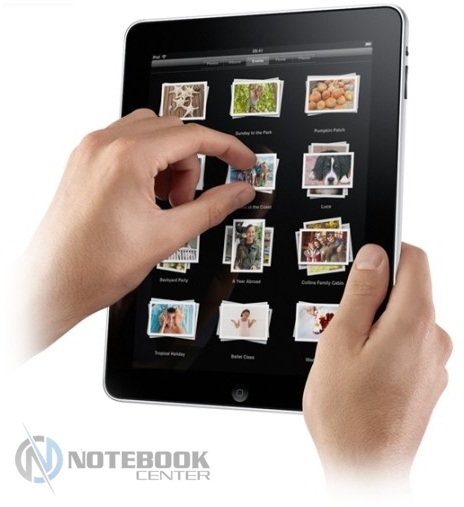
Flaws
The negative aspects of using a capacitive touch screen can include a higher cost due to the complexity of production. Interaction with the display is possible only when touching the material, which is a conductor. For this reason, special capacitive styluses or gloves are purchased to work with it, especially in cold weather, and this is another expense item.
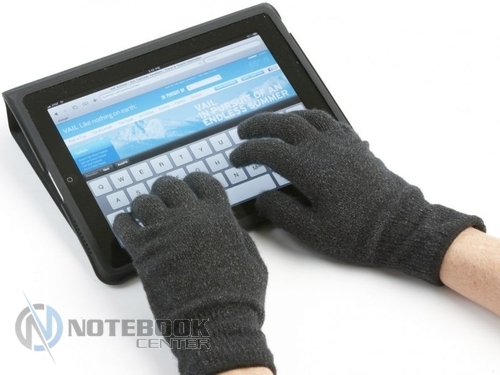
Conclusion
To summarize, we recall that resistive screens are pressure sensitive, while capacitive screens respond to touch. The accuracy of capacitive displays is comparable to the accuracy of resistive ones, but the capacitive type is more reliable due to the absence of a flexible membrane, and fewer layers make them more transparent.There is an opinion that resistive displays have already outlived their own, and the future belongs to capacitive ones. Indeed, the transition from a mechanical-electrical input to an electrical one already means a lot, since the accuracy of determining coordinates has increased, and multitouch has appeared.
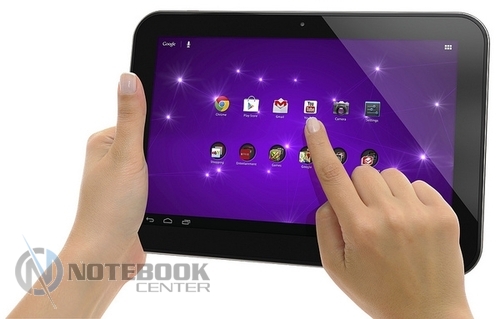
Nevertheless, today there are still a large number of devices with resistive screens on the electronics market, but they are slowly beginning to be replaced by gadgets with capacitive sensors. Observing this trend, we can assume that the former will soon disappear altogether.
Your phone's touchscreen: resistive, capacitive, or projected capacitive
Touch screens today are an integral attribute of a modern mobile phone, although they received mass distribution relatively recently - in 2007. And if you are going to buy a smartphone, you are unlikely to find among the new models those that would not be equipped with a touch screen. Despite the fact that adherents of conventional hardware keyboards are having a hard time switching to touch control, it is the touch devices that are being released more and more. And for those who appreciate comfortable typing, touch phones are released in a classic form factor or in a side slider form factor, which are additionally equipped with hardware QWERTY keyboards.
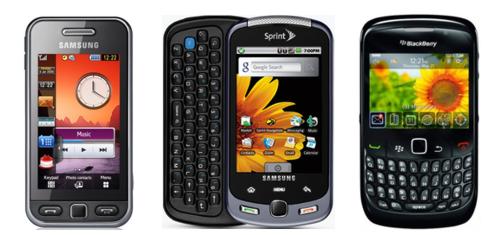
Touch phones and smartphones in different form factors
Often the phrase "touch screen" is replaced by another - "touchscreen", which is a bunch of two English words (touch - touch, touch and screen - screen). We are so used to touch screens that we often do not think about what they can actually be. different types. This article will focus on touch screens that are used in mobile phones and smartphones, so we will consider their classification in relation to this technique. In practice, touch screens are often used in other multimedia devices (tablets, monitors, etc.), as well as in medical and engineering equipment.
So, resistive, capacitive and projective-capacitive screens fall into our field of vision. Consider their advantages and disadvantages in order to decide which type of screen is most suitable for you.
Resistive touch screens
Screens of this type consist of two main layers - a flexible top layer (mainly made of plastic) and a rigid bottom layer (made of glass). The top layer has another function - protective. It protects the working area of the display from damage. You touch the top layer while working with a mobile device, and information about the touch coordinates is transmitted to the bottom layer. The inner sides of these layers are covered with a special membrane and conductive material. The layer between the two layers is a dielectric.
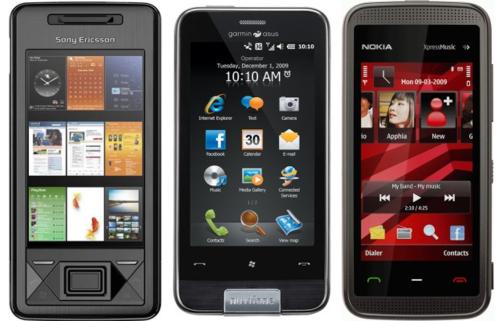
Examples of models with resistive touch screens
The main advantage of resistive touch screens is their low cost. Such screens are now installed by manufacturers on many mobile phones and smartphones of the middle price segment. It is the low cost of the screen that often makes it possible to reduce the price of such devices, making them more affordable.
Their second advantage is resistance to pollution. This means that even a screen surface covered with dust and water stains will still work well, and the pressure sensitivity will not change.
The third is that you can touch such a screen with any solid object. It can be a stylus, a fingernail, the tip of a pencil, a key, or any moderately sharp object that will be comfortable for you personally to work with.
If we talk about the shortcomings of resistive touch screens, then the first can be called its low durability. If we translate the life of such a screen into the number of clicks, then it will be 1 million clicks for four-wire screens and 35 million clicks for five-wire screens (the two most common types of resistive touch screens). Resistive screens transmit light very poorly (only about 80%). Despite the protective layer used, the operation of such a screen can be quite easily disrupted by damaging it. Plastic is easily cut with sharp objects, and its surface cannot withstand too high temperatures and can melt.
The popularity of resistive touch screens is still very high. It was they who made touch phones affordable and allowed to bring to the market a lot of inexpensive devices costing up to $200. Star, 5530 XpressMusic is one of the most popular devices in this segment.
Capacitive touch screens
Screens of this type are based on the ability of the human body to conduct electrical current. Most often, a capacitive screen is based on a glass substrate, on the surface of which a resistive material is applied, covered with a conductive film. At the moment of touching the finger screen, an electric current arises, and a special controller calculates the coordinates of the touch.
In terms of the accuracy of determining the coordinates, capacitive screens are in no way inferior to resistive ones, but at the same time they transmit light better (90% or more instead of 80%). The durability of such screens is an order of magnitude higher - they can withstand up to 200 million clicks. The impact of the environment on capacitive screens is less - ideally, they are able to work flawlessly in sultry heat and in severe cold.
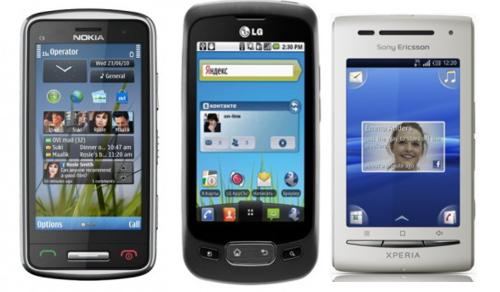
Examples of models with capacitive touch screens
The main disadvantage of this type of screens is the possibility of their operation only under the influence of a conductive object. That is, if you want to use a regular stylus or any other hard object, the screen will not react to your touch.
This problem is especially pronounced in winter, when on a frosty day, when answering an important call, there is no opportunity (or desire) to take off the glove and press the corresponding button on the screen. True, some owners of such phones have already found a rather original way out of this situation - instead of fingers to press this button, they use ... their nose! I must say that in some cases it is also possible to control a hand in a glove - this will depend on the quality of the screen and its sensitivity, as well as the material from which the glove is sewn.
Another disadvantage of capacitive touch screens is their high susceptibility to surface contamination. In this case, the sensitivity and accuracy of pressing can significantly decrease.
In fairness, it should be noted that styluses with electric capacity have already been created (for example, the manufacturer has such a model), but they have not received much distribution due to their high cost (about $30).
Projected capacitive touch screens
This type of screen differs from classic capacitive screens in only one way - it supports Multitouch technology. Their device is also slightly complicated, but the principle of operation remains the same. Such screens are able to track and process multiple clicks at the same time, which is widely used in mobile browsers and gaming applications. For example, two-finger rotation will rotate the image 90 degrees, and a multi-finger swipe will make it easier to scroll through the screen. True, the cost of screens made using this technology is still traditionally high, so they are installed on smartphones whose price is above $300.
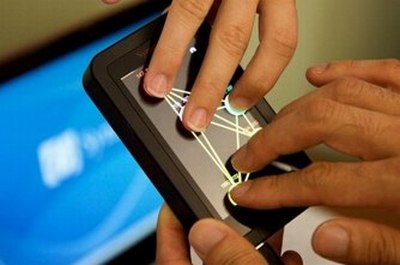
Multitouch in action
Projection-capacitive touch screens have many advantages - in addition to supporting Multitouch, they are durable (about 200 million touches), resistant to damage (for protective purposes, you can use tempered glass or special plastic up to 18 mm thick), withstand operation at very low temperatures (up to -40 °C), capable of transmitting light well (over 90%). Projection-capacitive screens have only one drawback - they can only be controlled using conductive objects (as is the case with conventional capacitive screens).
Most famous smartphones with projective-capacitive screens is manufactured by Apple, which also became a pioneer in this area. There is also a working Multitouch on models such as the Galaxy S II, HTC Desire S.
What to choose
If you are faced with the question of choosing a mobile device depending on the type of touch screen, you can first determine how much you are willing to spend on buying a phone or smartphone, what will be the operating conditions of the device, whether you agree to use only your fingers to control it. If you're willing to pay a hefty sum for Multitouch support and need a modern high-performance smartphone, choose a model with a projected capacitive screen. If you're buying a touchscreen phone for the first time and want to save money, a resistive screen is the way to go. He will best solution, if you are embarrassed by the need to control it exclusively with your fingers, or if you often work in not too sterile conditions, and particles of dirt and dust regularly get on the surface of the screen.
Most experts in this field predict a gradual exit from the market of resistive screens, but the range of models with such screens is still the largest, and the prices are pleasing to the eye and purse. New versions appear at the same time operating systems, which are perfectly adapted to finger control: they do not have too small buttons that are difficult to hit, and the number of actions for performing one operation is minimized.
Resistive or capacitive screen? Resistive! October 26th, 2014
How do the capacitive screens used in the iPhone and other modern mobile devices differ from other types of touch displays? And are they the future?
You need to select a RESISTIVE SCREEN!
Overview and clarifications
Repeatedly convinced that ordinary users are completely unaware of the existence of different types of touch screens and with genuine amazement learn that the lack of response of the display of a freshly bought communicator to the usual poking with a pencil is not at all a sign of a malfunction. It's just a different screen, built on a different technology. Even some sellers are confused in the testimony, attributing the properties of others to displays of one type. So first we will conduct a brief educational program, after which you will be able to distinguish different types of screens literally by touch. And then we'll talk about which one of them is the future.
In modern mobile devices - smartphones, communicators, players - two types of touch screens are used: resistive and capacitive. At the same time, more than 90% of all touch displays today are of the resistive type, although there has already been a clear trend towards an increase in the proportion of capacitive screens.
To stop getting confused, just remember: resistive screens are pressure sensitive, and capacitive screens are touch sensitive. This difference is due to the design of the displays, and, for example, it is impossible to accustom a capacitive screen to recognize pencil taps.
The resistive screen is a glass liquid crystal display on which a flexible membrane is superimposed. A resistive composition is applied to the contacting sides, and the space between the planes is separated by a dielectric. Electrodes (four or eight, five or six and seven) are fixed along the edges of the plates. It is easy to guess that when pressed, the screen and the membrane come into contact at the point of pressing, the coordinates of which are calculated by sequentially supplying current to the upper and lower plates and measuring the voltage at the point of contact between the plates. That is why you can press such a screen with any hard object - from a fingernail and a stylus to a pencil or a match, and it will work.
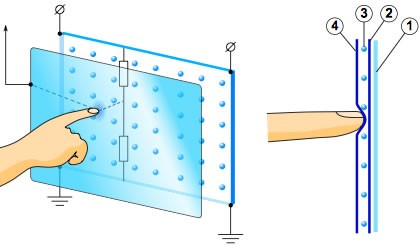
The principle of operation of the five-wire resistive shield
By design, resistive screens and, especially, their conductive layer are subject to gradual wear, which is why it becomes necessary to periodically calibrate the screen. The simplest and cheapest four-electrode screens can withstand only 3 million clicks at one point. Several times more reliable - up to 35 million clicks - five-wire, where four electrodes are located on the screen plate, and the fifth - on a membrane coated with a conductive compound and serving only as a kind of "probe". In addition, five-wire and its modifications of 6- and 7-wire shields continue to work even if part of the membrane is damaged.
The disadvantages of resistive screens also include low light transmission - no more than 70-85%, which requires increased backlight brightness. But these screens are extremely cheap to manufacture, which explains their wide distribution.
Capacitive touch screen general case It is a glass panel on which a layer of transparent resistive material is applied. Electrodes are installed at the corners of the panel, supplying a low-voltage alternating voltage to the conductive layer. Since the human body is capable of conducting electric current and has some capacitance, when the screen is touched, a leak appears in the system. The location of this leak, that is, the point of contact, is determined by the simplest controller based on data from the electrodes at the corners of the panel.
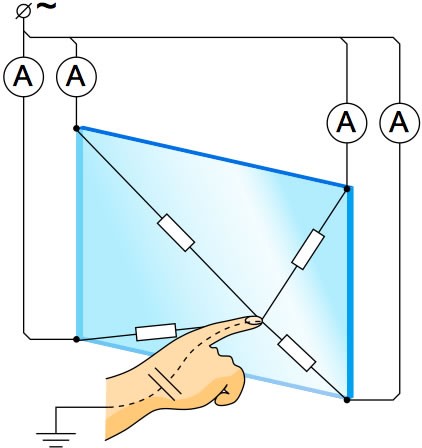
The principle of operation of the capacitive screen
There are no flexible membranes on the screen, which ensures high reliability and allows you to reduce the brightness of the backlight. Unfortunately, they cannot be poked with a stylus or a fingernail, since the command simply will not be recognized. Only with a finger. Such a screen also does not like negative temperatures: at best, the accuracy of determining coordinates falls, at worst, it simply stops responding.
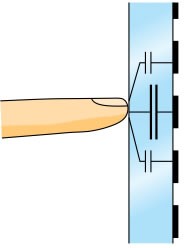
The principle of operation of the projection-capacitive screen
Unfortunately, on the simplest capacitive screen, which is now installed in the cheapest "touch" phones, it is impossible to organize a fashionable "multi-finger" multi-touch interface - four electrodes in the corners can record only one click at a time. Projection-capacitive displays are free from this drawback, in which a whole grid of conductors (or rows of electrodes) is applied to the back of the screen, to which a weak current is supplied, and the point of contact is determined by points with increased capacitance. By the way, such screens are able to respond even to the approach of a hand (and, therefore, to a gloved hand) - it all depends on the sensitivity settings.
Many experts, not without reason, believe that resistive screens are yesterday, and capacitive ones are the future. Indeed, the mere transition from a mechanical-electrical input system to a purely electrical one is, of course, progress. The reliability and accuracy of determining coordinates have grown, the need for calibration has disappeared, and a "multi-finger" interface has appeared.
The move away from resistive displays has spurred the development of truly user-friendly user interfaces optimized for fingertip control. In modern communicators, it is no longer necessary to aim a chip at microscopic interface elements inherited from "large" operating systems. Note, latest Windows Phone 7 is absolutely nothing like the rest of the family of "mobile windows" of previous generations, in which there was nothing to do without a tiny pen.
Skeptics will notice that you can no longer draw on a capacitive screen with an ordinary plastic stylus or some random object, you can’t write down a memo by hand. To do this, you have to buy a special stylus with an electrical capacity. HTC has even patented such a capacitive stylus (http://www.devicewire.co.uk/official-htc-hd2-capacitive-stylus) and is asking around $30 for it. But how often do we draw on the phone or use handwriting? As it is customary to express in certain circles, a little less often than never. And touchscreen drawing tablets use completely different technologies, and they are not going anywhere.
The only reason why resistive screens still have the lion's share of the market is because they are so cheap. In addition, in a few years, all the largest vendors have managed to produce so many of the most diverse and not at all cheap handsets with resistive displays that it would be like death for them to take them and write them down at once in the category of morally obsolete. In any case, there will be more and more devices with capacitive screens, and fewer and fewer with resistive ones. In a few years, we won’t even remember that we once poked smartphone screens with special thin slivers.
ANALYSIS AND CONCLUSION
Analyzing the principle of operation of two different screens, it can be concluded that in resistive the screen has no effect on the human body electromagnetic radiation and inconsistently current. Conversely, the screen capacitive it is practically an electromagnetic field in which you immerse your hand to perform certain actions. Moreover, this electromagnetic field begins to be physically felt already from a distance of 5-10 cm from the screen.
Do not forget that the blood in the human body is carried by hemoglobin, which contains iron in its composition. Using capacitive screen, you actually carry out electromagnetic processing of your blood, which then spreads these results throughout the body.
A rheumatic person, as the person most sensitive to effects on the cardiovascular system, will immediately say the answer: - "My arm hurts and my bones hurt in five minutes from the capacitive screen! Throw this shit away immediately! Don't give it to children!"
If you work a lot and often with touch screens, then always choose resistive. In principle, children should not be given access to capacitive screens. We do not need multi-touch if such a muck accompanies its use. Modify resistive screens to multi-touch and do not climb to us with capacitive screens.
Analysis and conclusion: Forensic technical examination of the institution of the CNEAT in Samara:
